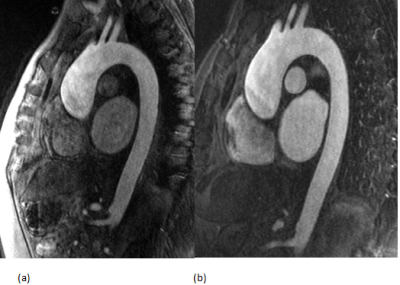Kaitlin Crawford1, Ali Serhal2, Olivia D. Reese2, Pascale Aouad2, Matthew Barrett2, Monica Korell2, Amir Rahsepar2, Monda Shehata2, Ahmadreza Ghasemiesfe2, Jeremy Collins2, and James Carr2,3
1University of Notre Dame, South Bend, IN, United States, 2Northwestern University, Chicago, IL, United States, 3Knight Family Professor of Cardiac Imaging, Chicago, IL, United States
Synopsis
Contrast enhanced Magnetic resonance imaging plays an
important role in the diagnosis and follow-up of patients with thoracic aortic
aneurysm (TAA). Gadoterate Meglumine, which has recently become available in
the US, is considered one of the safer gadolinium contrast agents with respect
to tissue deposition and NSF, due its macrocyclic structure. In this study, we
compare the qualitative image quality and quantitative aortic dimensions of
Gadoterate Meglumine enhanced MRA and compare it to Gadobutrol enhanced MRA for
evaluation of thoracic aortic disease. These preliminary results showed that Gadoterate
Meglumine enhanced MRA has comparable image quality to Gadobutrol enhanced MRA
and excellent correlation with respect to aortic diameter measurements.
Introduction
Thoracic aortic aneurysms (TAAs) and dissections
are responsible for more than 15,000 deaths yearly in the United States (1). Imaging
plays an important role in the diagnosis and follow-up of these patients. The
treatment depends on the diameter size of the aorta and on the growth rate,
making adequate image quality crucial when imaging these patients. Both
computed tomographic angiography and contrast enhanced magnetic resonance
angiography are equally validated techniques for imaging patients with TAA (2).
However, there is concern for gadolinium administration in patients with impaired
renal function, due to risk of developing nephrogenic systemic fibrosis (NSF). More
recently, there have been reports of tissue deposition, particularly in brain
tissue, with Gadolinium contrast agents. The aim of the study was to evaluate
the performance of Gadoterate meglumine enhanced MRA of the thoracic aorta when
compared to Gadobutrol, used for routine clinical imaging at our institution.Methods
This study was IRB approved and informed consent
was obtained. The study population
consisted of 14 patients with known or suspected TAA presenting for routine
follow up with CE MRA of the thoracic aorta. All patients underwent thoracic
Gadobutrol enhanced MRA as a routine clinical scan and returned on average 5
weeks later for a research Gadoterate Meglumine MRA. The injection rate and
volume were the same for both studies. Measurements of the aortic diameters
were obtained at the levels of sinus of Valsalva, Sino-tubular junction,
ascending aorta, proximal arch, distal arch and distal descending aorta for
both scans. The average diameters for each measurement were calculated and correlation
was assessed by linear regression analysis. Qualitative analysis consisted of
two radiologists, blinded to the type of contrast used, scoring 4 arterial
segments for image quality, signal-to-noise ratio (SNR) and contrast-to-noise
ratio (CNR) using a 5-point Likert scale. Results
Qualitatively, there was no significant
difference in image quality, SNR and CNR between both images for both reviewers
(ICC>0.8). Quantitatively, there was an excellent agreement between aortic
diameter measurements for both scans (r2=0.89, p<0.001) at all
measured aortic levels. Discussion
Gadoterate Meglumine enhanced MRA showed comparable diagnostic
image quality when analyzing the thoracic aorta in patients with thoracic
aortic aneurysms with excellent correlation of aortic measurements when
compared to Gadobutrol scans. Conclusion
Gadoterate Meglumine enhanced MRA is comparable
to gadobutrol enhanced MRA for imaging patients with thoracic aortic aneurysms,
providing adequate image quality and precise measurements of the aortic
diameters.Acknowledgements
No acknowledgement found.References
1. Clouse WD, Hallett JW Jr, Schaff HV, Spitettell PC,
Rowland CM, Illstrup DM, Melton LJ. Acute aortic dissection: population-based
incidence compared with degenerative aortic aneurysm rupture. Mayo Clin Proc.
2004;79:176-180.
2. Laura A. Freeman, Phillip M. Young, Thomas A.
Foley, Eric E. Williamson, Charles J. Bruce, Kevin L. Greason. CT and MRI Assessment of the Aortic Root and
Ascending Aorta. American Journal of Roentgenology. 2013;200: W581-W592.
10.2214/AJR.12.9531
3. Kirchin MA, Runge VM. Contrast agents for magnetic
resonance imaging: safety update. Top Magn Reson Imaging. 2003;14(5):426–35.

